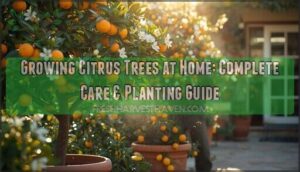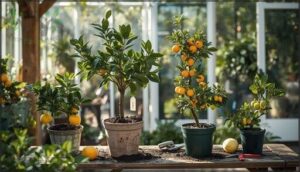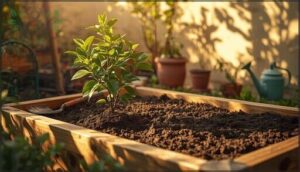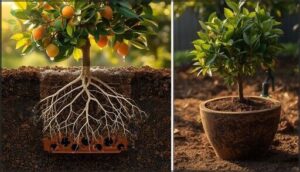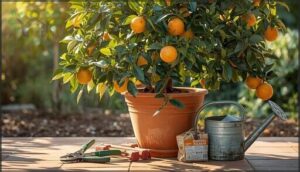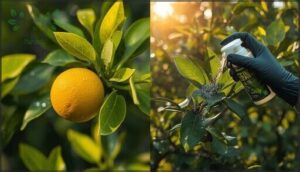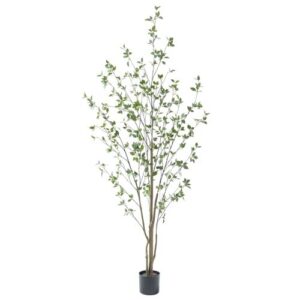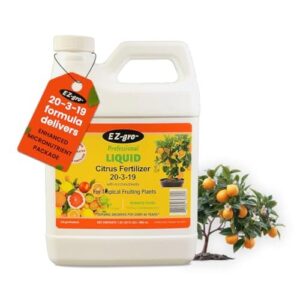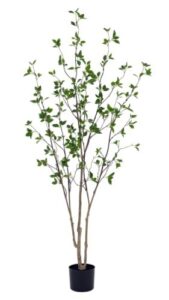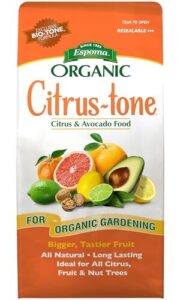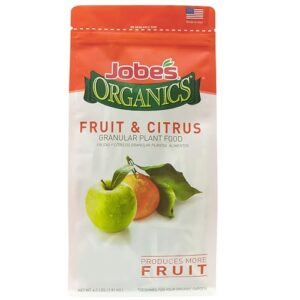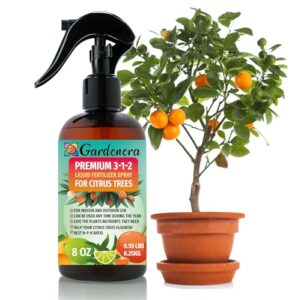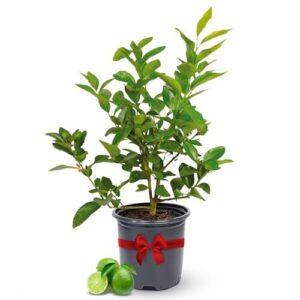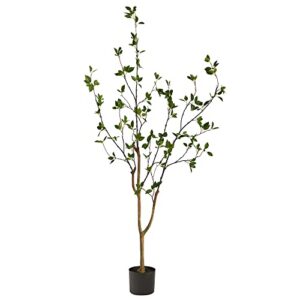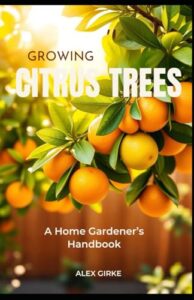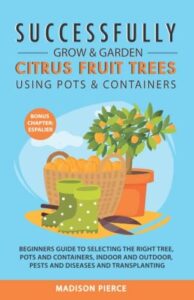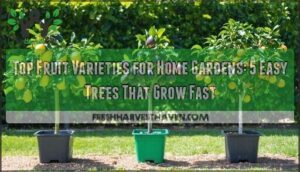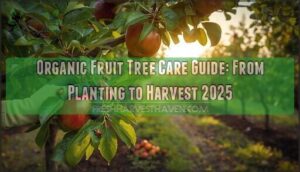This site is supported by our readers. We may earn a commission, at no cost to you, if you purchase through links.
The scent of orange blossoms drifting through your kitchen window isn’t reserved for California estates anymore. Growing citrus trees at home has become surprisingly accessible for anyone with a sunny spot and a bit of patience, whether you’re working with a sprawling backyard or a modest apartment balcony.
These glossy-leaved beauties don’t just deliver fresh, tangy fruit—they transform spaces with fragrant blooms, purify indoor air, and reconnect you with the rhythm of nature’s seasons.
The learning curve isn’t steep, but choosing the right variety and mastering a few key care techniques makes all the difference between a struggling sapling and a productive tree that rewards you for years.
Table Of Contents
- Key Takeaways
- Why Grow Citrus Trees at Home
- Choosing The Right Citrus Tree
- Preparing The Ideal Planting Site
- Planting and Repotting Citrus Trees
- Essential Citrus Tree Care Tips
- Managing Pests, Diseases, and Deficiencies
- Top 10 Citrus Tree Products for Home Gardeners
- 1. Bellacat 7ft Artificial Citrus Tree
- 2. EZ Gro Citrus Tree Fertilizer
- 3. Haplant 6ft Faux Citrus Tree
- 4. Espoma Organic Citrus Tone Plant Food
- 5. Jobe’s Organics Fruit and Citrus Fertilizer
- 6. Gardenera Citrus Tree Fertilizer Mist Spray
- 7. Persian Lime Tree Indoor Fruit Tree
- 8. Nearly Natural Minimalist Citrus Tree
- 9. Growing Citrus Trees Home Garden
- 10. Citrus Trees in Pots and Containers
- Frequently Asked Questions (FAQs)
- Conclusion
Key Takeaways
- Growing citrus trees at home works in most spaces—from backyards to balconies—if you provide 6-8 hours of daily sunlight, well-draining soil with pH 6.0-7.0, and choose grafted dwarf varieties that fruit within 1-3 years instead of seed-grown trees that take 5-10 years.
- Success hinges on mastering four core practices: watering deeply every 7-10 days for mature trees (adjusting for container plants), fertilizing three times yearly with balanced NPK formulas, pruning 10-30% of branches annually in late winter, and protecting trees when temperatures drop below 40°F.
- Common problems like yellowing leaves, pest infestations, and nutrient deficiencies resolve quickly when you maintain proper drainage, apply organic controls like neem oil or beneficial insects, and correct soil pH between 5.8-6.5 to prevent micronutrient lockout.
- Container growing demands specific attention—use 18-24 inch pots with multiple drainage holes, repot every 2-3 years in early spring, and increase watering frequency since containers dry faster than ground soil while limiting root space compared to in-ground planting.
Why Grow Citrus Trees at Home
Growing citrus trees at home offers more than just a gardening hobby—it’s a rewarding experience that touches multiple aspects of your daily life. From the fresh fruit on your kitchen counter to the vibrant greenery brightening your space, citrus trees deliver practical and aesthetic value.
Let’s explore the key reasons why adding a citrus tree to your home makes sense for both new and experienced gardeners.
Health and Culinary Benefits
Home-grown citrus fruit delivers impressive vitamin C levels—a single orange provides about 78% of your daily needs—while offering powerful antioxidant support for heart health and immune function. Citrus fruits are also known to have anti-inflammatory effects.
You’ll enjoy fresh culinary uses, from zesting to juicing, that boost flavor and nutrition. Different citrus varieties expand your culinary creations, giving you pesticide-free fruit flavors at peak ripeness, optimizing both taste and the home benefits of citrus fruit production.
Enhancing Home Gardens and Interiors
Beyond the kitchen, citrus varieties bring vibrant beauty to your living spaces. Dwarf citrus trees in pots fit easily into patios or indoor rooms, occupying less than 2 square meters while providing year-round greenery. Their fragrant blossoms naturally improve air quality and reduce stress—studies show citrus aromas can boost alertness and mood. Container gardening with indoor citrus trees transforms ordinary spaces into sensory retreats. They also provide a daily dose of vitamin C, contributing to a healthier lifestyle.
- Evergreen foliage and colorful fruit create visual interest in any season
- Natural fragrance compounds like limonene freshen indoor air without chemicals
- Compact varieties such as calamondin thrive in containers as small as 10 liters
- Home citrus cultivation promotes psychological wellbeing through direct plant care
- Space optimization allows aesthetic integration even in apartments or small yards
Year-round Access to Fresh Fruit
Citrus fruit can also deliver a steady harvest calendar that’s hard to match. When you grow varieties like Meyer lemons or limes, you’ll notice continuous fruiting throughout the year—unlike oranges, which follow a single annual cycle. Indoor harvests mean extended ripening periods, and supply reduction at the market won’t disrupt your kitchen plans.
| Citrus Type | Typical Harvest Window |
|---|---|
| Meyer Lemon | August–February (peak) |
| Valencia Orange | Late spring–mid-summer |
| Grapefruit | November–June |
| Mandarin | December–May |
Achieving bountiful harvests requires attention to seasonal availability patterns and proper fertilization timing. Fruit production remains flexible: ripe citrus stays edible on the tree for weeks, giving you control over harvesting schedules. This rhythm keeps your supply fresh and reduces waste.
Connecting With Nature and Sustainability
Tending citrus trees at home offers more than fresh fruit. You’ll find that home horticulture brings stress reduction and strengthens your connection to living systems.
Sustainable management practices like organic pest control and building soil health with organic matter improve ecosystem services in your own yard.
Citrus cultivation can lower your carbon footprint while supporting community benefits through shared knowledge and environmental stewardship.
Choosing The Right Citrus Tree
Your citrus success starts with picking the right tree for your specific situation. Climate, available space, and what kind of fruit you’re craving all play a role in making that choice.
Let’s walk through the main factors you’ll want to think about before bringing your citrus tree home.
Assessing Your Climate and Space
Your climate dictates which citrus trees will flourish or flounder. First, identify your USDA Zones—citrus thrives in zones 9 to 11, though microclimates matter and may offer surprising pockets of warmth.
Map your sunlight carefully; you’ll need six to eight hours of direct light daily. Don’t overlook space limitations or soil drainage.
If growing conditions fall short outdoors, indoor options with proper environmental control can save the day.
Popular Beginner-friendly Varieties
Several citrus trees welcome new growers with open arms. Meyer lemons stand out for sweeter fruit and continuous production, while Bearss limes deliver tart, reliable yields. Calamondin offers year-round fruiting with minimal fuss, and mandarin types like Satsuma tolerate cold surprisingly well. Kumquats thrive in containers and require little pampering.
Choosing citrus varieties that match your experience level ensures dwarf varieties or standard trees succeed from day one.
Dwarf Vs. Standard Citrus Trees
When choosing citrus trees, size shapes your entire growing experience. Dwarf varieties reach only 6–10 feet and thrive in container gardening, while standard trees tower beyond 20 feet and demand ground space.
Here’s what sets them apart:
- Fruit yield: Dwarf trees produce roughly 50% less per tree but allow denser plantings
- Root system: Dwarf roots stay shallow, needing consistent watering
- Home suitability: Dwarf types fit patios perfectly; standard trees need yards
Selecting Grafted Vs. Ungrafted Trees
Grafted trees reach fruiting maturity in 4–5 years, while ungrafted citrus trees may take 6–15 years. Grafted varieties produce 25% higher annual yields with consistent fruit size and flavor.
Rootstock benefits include better performance in challenging soils, boosting productivity by 10–15%. Ungrafted trees show genetic variation, making fruit outcomes unpredictable.
When choosing citrus trees, grafted options deliver reliable harvests faster.
Preparing The Ideal Planting Site
Getting your planting site right is half the battle when it comes to growing thriving citrus trees. Whether you’re setting up a sunny corner in your backyard or creating an indoor citrus haven, you’ll need to think about a few key factors that make all the difference.
Let’s walk through the essentials—from sunlight and location to soil preparation and container selection—so your citrus tree has everything it needs from day one.
Sunlight Requirements for Optimal Growth
Your citrus tree’s success depends heavily on sunlight exposure—it’s the fuel that powers fruit production. Aim for 6 to 8 hours of direct sunlight daily to get the most out of growth and yields.
Here’s what proper sunlight duration delivers:
- Stronger flowering and fruiting with full sun exposure
- Sweeter, larger fruit when light intensity meets plant needs
- Healthy leaf adaptation that boosts chlorophyll production
- Consistent harvests despite seasonal variation in daylight hours
Selecting Outdoor or Indoor Locations
Your first big decision is whether to keep your tree outdoors or indoors—each environment shapes health outcomes differently.
Outdoor citrus trees in USDA zones 9–11 enjoy natural air circulation and abundant sunlight, thriving with minimal intervention.
Indoor citrus trees need south-facing windows for adequate light exposure and attention to temperature tolerance, generally 65°F daytime.
Consider spatial constraints, water access, and your willingness to manage humidity before committing to a location.
Preparing Well-draining Soil
Once you’ve settled on location, your success literally depends on what’s beneath the surface—soil preparation determines root health from day one. Well-draining soil prevents waterlogged roots and oxygen deprivation, the top killers of home citrus. Proper soil composition, drainage assessment, and pH balance lay the groundwork for years of fruiting.
Here’s what soil conditions demand:
- Test drainage by filling a 2–3 foot hole with water; it should drain within 24–36 hours.
- Aim for sandy clay loam with pH 6.0–7.0 for best nutrient availability.
- Incorporate soil amendments like gypsum or compost to improve structure in heavy clay.
- Build raised beds 45–50 cm high if your site has poor natural drainage.
Choosing Containers for Home Citrus
When container gardening becomes your path forward, pot selection shapes every watering decision and repotting schedule ahead. Choosing a pot means balancing drainage solutions, pot size, and movability options—dwarf citrus trees for pots thrive in 18–24 inch containers holding 15–20 gallons of soil.
| Container Material | Key Trade-off |
|---|---|
| Plastic/Resin | Retains moisture; lightweight for moving |
| Terracotta/Clay | Enhances aeration; dries out faster |
| Wood (Half Barrels) | Natural insulation; eventual decay |
| Ceramic/Metal | Aesthetic choices; can heat roots excessively |
Choosing the right pot with multiple drainage holes prevents root rot and sets your tree up for decades of fruiting success.
Planting and Repotting Citrus Trees
Getting your citrus tree into the ground—or into the right container—sets the stage for years of healthy growth and abundant harvests. Whether you’re planting a young sapling outdoors or setting up a potted lemon tree on your patio, the techniques you use now will directly impact root health, nutrient uptake, and long-term productivity.
Let’s walk through the essential steps to plant and repot your citrus trees with confidence.
Step-by-step Planting Instructions
When planting your citrus tree, start by selecting a site at least 6 feet from structures or other trees. Remove grass in a 3–5-foot diameter circle around your planting hole.
Dig a hole 1.5 to 2 times wider than your root ball, matching its depth. Clip any circling roots, position the tree level with surrounding soil, backfill halfway, water thoroughly, then complete filling and form a 3-inch berm.
How to Choose and Size Pots
Your citrus trees in pots need the right foundation. Start with a 10- to 14-inch pot for young trees, then upsize every three to five years to match canopy growth. Mature dimensions reach 18–24 inches wide, balancing root health and mobility.
Container gardening success hinges on:
- Drainage solutions: Multiple holes prevent waterlogged roots
- Container material: Terra-cotta breathes; plastic retains moisture
- Pot upsizing: Increase diameter by 30% each move
Choosing the right pot prevents root restriction while supporting healthy fruiting.
Repotting Techniques and Timing
Every two to three years, your citrus needs a bigger home—annually if it’s still young. Watch for rootbound symptoms like exposed roots or slowed growth signaling it’s time to repot.
Early spring offers the best repotting season, minimizing transplant shock. Loosen the root ball, trim dead roots, and position the crown slightly above soil level in fresh potting mixes.
Water deeply, then shade your tree for two weeks as post-repotting care.
Ensuring Proper Drainage and Root Health
Without proper drainage, root rot can devastate your citrus tree—even if you’ve done everything else right. You need multiple drainage holes in containers and well-draining soil with a pH between 5.5 and 7.0.
Mounding benefits outdoor trees by elevating the root system above poor soil conditions.
Smart irrigation methods prevent waterlogging, keeping fibrous roots healthy and productive year-round.
Essential Citrus Tree Care Tips
Once your citrus tree is settled in its new home, the real work begins—keeping it healthy and productive year after year. Success comes down to nailing four key practices: watering consistently, feeding at the right times, pruning strategically, and managing your tree’s environment.
Let’s walk through each one so you can give your citrus the care it needs to thrive.
Watering Schedules and Methods
Watering citrus trees correctly makes all the difference between a thriving plant and a struggling one. You’ll need to adjust your approach based on the tree’s age, season, and soil type. Here’s what works:
- Water newly planted trees daily for four weeks, then shift to weekly or bi-weekly sessions
- Give mature trees 21–31 gallons every 7–10 days in summer; reduce frequency in winter
- Check soil moisture 2–3 inches down before watering
- Use drip irrigation or soil moisture sensors for precision
- Match watering frequency to your soil’s drainage characteristics
Fertilizing for Healthy Fruiting
Think of fertilizing citrus trees as feeding a hungry athlete—timing and nutrition matter. You’ll want to fertilize three times yearly (February, May, September) using NPK ratios like 8-8-16 for fruiting or balanced citrus fertilizer such as 6-6-6 for young trees. Container-grown citrus benefit from liquid fertilizer products every two weeks.
Don’t forget micronutrients—zinc and manganese deficiencies are common. Organic vs. synthetic? Both work, though organic fertilizers improve soil health long-term. Proper application timing maximizes fruit quality.
Pruning for Shape and Productivity
Pruning citrus trees shapes them and boosts fruit production. You’ll want to use sharp pruning shears in late winter or right after harvest, removing 10–30% of branches annually for best growth.
This improves light penetration and air circulation, enhancing fruit quality while reducing disease by up to 20%.
Regular pruning means better yields, healthier trees, and easier harvesting—economic benefits that pay off season after season.
Temperature and Humidity Management
Your citrus trees flourish when daytime temperatures hover between 65°F and 85°F—think of it as their comfort zone. Ideal temperatures matter because prolonged cold weather below 40°F triggers leaf drop, while humidity control between 50–60% prevents stress.
Use frost protection like covers when temperatures approach 32°F, and consider climate adaptation strategies such as moving containers indoors during harsh conditions.
Managing Pests, Diseases, and Deficiencies
Even healthy citrus trees face occasional challenges from pests, diseases, and nutritional imbalances that can affect their growth and fruit production. Understanding how to identify and address these issues early keeps your trees thriving year-round.
Let’s explore the most effective strategies for protecting your citrus investment.
Common Citrus Pests and Natural Controls
From leafminers to citrus aphids, your trees can face quite a few troublemakers. Pest identification is your first defense—look for scale insects, whiteflies, and spider mites.
Here are effective organic pest control strategies:
- Neem oil reduces aphid and mealybug populations by 70–95% within two weeks
- Ladybugs and lacewings decrease aphid numbers by 65–90% naturally
- Tamarixia radiata wasps suppress psyllid populations by over 70%
- Sticky traps control up to 75% of whitefly infestations indoors
- Kaolin clay applications reduce pest egg-laying by 75%
Biological controls and IPM strategies help you manage infestation rates without harsh chemicals. Natural remedies like insecticidal soaps work wonders on soft-bodied pests, while regular pruning cuts pest incidence by 50%. These methods form the backbone of successful disease control.
Preventing and Treating Citrus Diseases
While pest control addresses the invaders, disease prevention requires a different playbook. Early detection makes all the difference—citrus greening has no cure, so you’ll need to remove infected plants quickly. Quarantine implementation stops spread within five-mile zones, while biological pest controls like Bacillus subtilis reduce black spot severity.
| Disease Challenge | Management Strategy |
|---|---|
| Citrus Greening (HLB) | Remove infected trees within 5 years; monitor psyllids |
| Citrus Canker | Apply copper sprays; use tree row volume method |
| Black Spot | Bacillus subtilis treatment; early harvest |
| Variegated Chlorosis | Eliminate symptomatic plants; prune aggressively |
| General Prevention | Plant disease-free stock; maintain sanitation |
Integrated disease management combines chemical treatments with cultivar disease resistance for your best defense.
Nutrient Deficiencies and Soil PH Management
Beyond battling pathogens, your citrus tree’s health hinges on balanced nutrition and proper soil pH. Over 60% of orchards battle zinc deficiency, while nearly half of home trees show nitrogen shortfalls—both robbing you of vigorous growth and fruit. Here’s how to diagnose and fix common nutrient problems:
- Nitrogen deficiency: Pale, yellowing leaves signal trouble; expect 30% yield drops if uncorrected.
- Zinc shortage: Small, narrow foliage delays fruit maturity and lowers quality.
- Iron issues: Young leaves develop interveinal chlorosis (yellowing between veins).
- Magnesium gaps: Older leaves yellow along the midrib—affects 20% of home citrus.
- pH imbalance: Soil below 5.0 risks aluminum toxicity; above 7.5 locks out phosphorus.
Aim for soil pH between 5.8 and 6.5 for best nutrient uptake. Drop below 4.5, and you’ll lose nearly half your fruit yield.
Remediation practices like dolomitic lime correct acidity while supplying magnesium, and foliar sprays deliver micronutrients faster than soil amendments. Split your fertilizer applications from March through September—mature trees need nitrogen rates equivalent to 120–240 pounds per acre yearly, scaled down for containers. Test your soil annually, adjust pH promptly, and watch deficiency symptoms vanish as essential nutrients flow freely again.
Seasonal Care and Winter Protection
Once nutrients are balanced, winter protection becomes your next hurdle—especially when frost threatens. Citrus fruit suffers damage after just four hours at 28°F, and lemons lose blossoms at 29°F. Cold weather quickly erodes your yield outcomes if you don’t act.
Indoor overwintering works best: bring trees inside before nights dip below 40–45°F. Maintain 55–68°F with eight hours of sunlight, ensuring humidity control around 50% to prevent leaf drop. Outdoor options include frost cloths (raising temperature by 2–5°F), trunk wraps, and incandescent lights for added warmth.
Kumquats and Satsumas tolerate brief dips to 18–20°F, but most citrus need active protection below 26°F. Shift plants gradually over 7–10 days to minimize shock, inspect for pests, and reduce watering during the dormant season—winter fertilization isn’t recommended.
| Protection Method | Temperature Benefit |
|---|---|
| Frost cloths | +2–5°F canopy warmth |
| Incandescent lights | +4°F localized heat |
| Pre-freeze irrigation | Increases soil retention |
| Pebble humidity trays | ~50% indoor humidity |
| Gradual acclimation | 70% less spring leaf drop |
Proper overwintering boosts survival rates to 90% in Zone 8 for hardy varieties and maintains 40% higher fruit retention. Temperature thresholds matter: protect before prolonged subfreezing spells to keep your citrus thriving year after year.
Top 10 Citrus Tree Products for Home Gardeners
Growing healthy citrus trees at home depends on having the right tools and products to support their needs throughout the year. From fertilizers that boost fruiting to decorative alternatives for low-light spaces, the market offers a wide range of options designed for home gardeners.
Here are ten standout products that can help you nurture thriving citrus trees or bring citrus beauty into your space.
1. Bellacat 7ft Artificial Citrus Tree
If you’re seeking the visual charm of citrus trees for home without the ongoing plant care, the Bellacat 7ft Artificial Citrus Tree offers a compelling solution. This faux citrus tree stands 84 inches tall with realistic design elements, including UV-resistant synthetic foliage displaying clear veins and vivid color gradients.
Its maintenance needs are minimal—no watering, fertilizing, or pruning required—making it ideal for indoor suitability in offices, living rooms, or covered patios.
Market reception has been positive, with ratings above 4.7 stars and return rates below 2%. The decor versatility suits modern, Mediterranean, and transitional interiors.
Best For: Homeowners and office managers who want a tall, realistic-looking citrus tree without any plant maintenance, especially in spaces that lack natural sunlight or outdoor access.
- Zero maintenance required—no watering, fertilizing, or pruning needed, making it perfect for busy lifestyles or low-light environments.
- Highly realistic appearance with UV-resistant foliage featuring clear veins and vivid color gradients that stay fresh-looking for years.
- Quick and easy assembly in under 20 minutes with flexible branches you can customize to fit your space and style.
- Some buyers report the tree appears shorter than expected, potentially requiring a taller planter to reach the desired height.
- Not recommended for uncovered outdoor use, as prolonged direct rain or extreme UV exposure may cause faster material degradation.
- The foliage may appear too uniformly green for those seeking more varied or muted citrus leaf coloring.
2. EZ Gro Citrus Tree Fertilizer
For citrus trees craving a nutritional boost, EZ Gro Citrus Tree Fertilizer delivers professional-grade results in a concentrated liquid form. Its 20-3-19 NPK ratio meets nitrogen and potassium needs while the micronutrient blend resolves deficiency correction—think iron chlorosis and magnesium shortfalls common in container citrus.
You’ll fertilize monthly from spring through early fall, mixing one ounce per gallon. Application rates scale to your tree’s trunk diameter. While liquid vs granular options exist, this formula absorbs faster.
Safety handling is straightforward with the included measuring cup, and regulatory compliance ensures peace of mind.
Best For: Citrus and tropical fruit tree owners dealing with nutrient deficiencies or wanting fast-acting, professional-grade fertilization for both potted and in-ground trees.
- Fast absorption delivers visible results like greener leaves and new growth within days, unlike slow-release granular fertilizers that take weeks.
- Targeted micronutrient blend with iron, zinc, magnesium, and manganese effectively corrects common citrus deficiencies like leaf yellowing and poor fruiting.
- Concentrated formula stretches far—one quart makes up to 16 gallons of nutrient solution, with customizable dilution for different tree sizes and conditions.
- Higher upfront cost at $18.97 per bottle compared to granular fertilizer options, though the concentration offsets some expense.
- Requires monthly mixing and application during growing season, which is more hands-on than set-and-forget slow-release products.
- Flimsy measuring cup included with the product may break easily, and larger trees need significant amounts per watering session.
3. Haplant 6ft Faux Citrus Tree
When live citrus cultivation isn’t feasible, the Haplant 6ft Faux Citrus Tree offers a clever alternative. Its realistic appearance mimics authentic foliage without plant care demands—no watering, pruning, or sunlight concerns.
You’ll find design applications spanning kitchens to offices, supported by market trends showing faux citrus trees dominating indoor décor. The flexible branches adapt to your container gardening aesthetic, while sustainability aspects include eco-friendly plastics and recyclable packaging.
This maintenance-free option benefits households where potted plants struggle, delivering year-round greenery for your indoor citrus trees vision.
Best For: Homeowners and renters who want the look of indoor citrus trees without the hassle of watering, sunlight requirements, or ongoing plant care.
- Realistic trunk texture and bright green foliage that stays vibrant year-round without any maintenance beyond occasional dusting.
- Flexible branches let you customize the shape to fit your space, whether it’s a tight corner or an open room.
- Made with flame-retardant materials and includes a stable nursery planter, making it safe for homes with kids or pets.
- Constructed from plastic rather than eco-friendly materials, which may not appeal to sustainability-focused buyers.
- Some customers report the tree arriving sparser or more delicate than expected based on product photos.
- Limited to indoor use only, so it won’t work for patios, porches, or outdoor décor needs.
4. Espoma Organic Citrus Tone Plant Food
For thriving citrus trees, you’ll want a fertilizer that works with nature rather than against it. Espoma Organic Citrus Tone Plant Food delivers a 5-2-6 NPK formula enhanced with calcium and Bio-tone microbes, earning its organic certification and OMRI listing.
Application guidelines recommend feeding three times yearly—late winter, late spring, and early fall. The feeding effects show impressive results: greener foliage, larger fruit yields, and enhanced flavor.
Container usage requires more frequent fertilizing every 60 days due to nutrient leaching. This citrus tree fertilizer’s safety profile ensures worry-free use around family and pets.
Best For: Home gardeners growing citrus, avocado, or fruit trees who want an organic fertilizer that improves soil health while delivering consistent nutrients throughout the growing season.
- OMRI-listed organic formula with Bio-tone microbes enhances nutrient absorption and promotes healthier, more productive trees with larger fruit yields.
- Slow-release granules reduce the risk of burning roots and provide long-lasting nutrition with just three applications per year for in-ground trees.
- Safe for people, pets, and the environment with no synthetic chemicals or sewage sludge, manufactured in a solar-powered facility.
- Strong odor requires outdoor-only use and should be kept away from dogs who may be attracted to the smell.
- Container plants need more frequent feeding every 60 days compared to in-ground trees, increasing maintenance requirements.
- May attract mold or parasites in humid conditions, potentially requiring additional treatments like neem oil to manage.
5. Jobe’s Organics Fruit and Citrus Fertilizer
When you’re ready to feed your trees with something that works alongside nature’s own systems, Jobe’s Organics Fruit and Citrus Fertilizer offers a 3-5-5 NPK ratio loaded with essential nutrients from feather meal, bone meal, and beneficial microorganisms.
Apply this organic fertilizer every 2–3 months during the growing season at the tree’s drip line. Consumer reviews consistently praise its ease of use and environmental impact—reducing nitrogen runoff by 75% compared to synthetic options.
The cost comparison shows organic programs running about $35–$40 annually per tree.
Best For: Home gardeners and backyard orchardists who want an organic, slow-release fertilizer that improves soil health while feeding citrus and fruit trees safely around kids and pets.
- OMRI-listed organic formula with beneficial microorganisms reduces chemical runoff by up to 75% compared to synthetic fertilizers while improving long-term soil structure.
- Easy application every 2–3 months costs around $35–$40 annually per tree, making it more economical than synthetic programs that require frequent feeding.
- Studies show trees treated with this fertilizer produce fruit with 15% higher sugar content and 25% fewer pest problems due to stronger root development.
- Strong, unpleasant odor from organic ingredients like feather meal and processed manure may attract pets and requires secure storage.
- Not suitable for indoor use due to the smell, limiting options for potted citrus kept inside.
- Proprietary Biozome blend lacks full ingredient transparency, which may concern gardeners who want to know exactly what they’re applying.
6. Gardenera Citrus Tree Fertilizer Mist Spray
If you want a foliar fertilizer that simplifies citrus tree care, Gardenera’s Citrus Tree Fertilizer Mist Spray delivers an NPK ratio of 1-0.03-13 along with 18 essential vitamins, minerals, and bio-organisms.
Spray weekly from about 12 inches away, covering leaves and stems evenly. Performance outcomes include lush foliage and stronger disease resistance, often visible within 3–4 weeks.
User satisfaction remains high due to its ease of application and consistent results. Made in the USA, this citrus fertilizer meets strict safety standards without synthetic additives.
Best For: Home gardeners growing citrus trees indoors or outdoors who want a convenient, ready-to-use spray that delivers essential nutrients without mixing or measuring.
- Ready-to-use mist format makes application simple—just shake, spray from 12 inches away, and you’re done, with no mixing or complicated measuring required.
- Comprehensive nutrient blend includes 18 vitamins and minerals plus beneficial micro-organisms that support healthy foliage, stronger roots, and better disease resistance.
- Made in the USA with an organic, chemical-free formula that’s safe for indoor use and environmentally responsible compared to synthetic alternatives.
- Weekly application schedule means you’ll go through bottles faster than slow-release granular options, potentially increasing long-term costs.
- The 8 oz bottle size might not last long if you’re maintaining multiple or large citrus trees, requiring frequent reordering.
- Results vary among users, and while many see improvements within 3–4 weeks, some citrus varieties or growing conditions may respond differently.
7. Persian Lime Tree Indoor Fruit Tree
While foliar sprays offer convenience, live Persian Lime Tree Indoor Fruit Tree specimens bring year-round indoor fruiting and glossy foliage to your space.
Grafted trees reach fruiting maturity within 1 to 2 years, producing 20 to 40 seedless limes annually when given 6 to 8 hours of direct sunlight and temperatures between 70°F and 90°F.
Container citrus growing requires at least a 5-gallon pot with excellent drainage. Pruning needs remain moderate—trim in late winter for improved airflow.
Pest resistance against aphids and scale simplifies citrus tree care, making growing citrus indoors manageable for beginners.
Best For: Home gardeners who want fresh limes year-round and have a sunny indoor spot or patio with space for a compact fruiting tree.
- Produces 20 to 40 seedless limes per year once mature, with peak harvests in late autumn and winter but fruit available year-round.
- Reaches fruiting maturity quickly (1 to 2 years for grafted trees) and stays manageable at 8 to 10 feet tall indoors with pruning.
- Naturally resistant to common pests like aphids and scale, making it easier to maintain without heavy chemical treatments.
- Requires 6 to 8 hours of direct sunlight daily, which can be challenging in darker homes without supplemental grow lights.
- Cannot be shipped to CA, AZ, TX, LA, and other USDA-restricted areas due to citrus regulations.
- Leaves may dry out or drop during the transition period after shipping, requiring patience during initial acclimation.
8. Nearly Natural Minimalist Citrus Tree
For spaces lacking light or climate control, Nearly Natural’s 8-foot Minimalist Citrus Tree offers faux citrus trees that capture citrus aesthetics without horticultural demands. This synthetic option suits container citrus gardening enthusiasts facing environmental limitations—no watering, fertilizing, or pest management required.
Its bendable branches allow customization for indoor citrus trees styling in contemporary home gardening spaces.
Market trends show growing popularity for maintenance-free greenery, and this model delivers design applications with minimal environmental impact. While it won’t fruit, you’ll gain year-round minimalist aesthetics in challenging indoor conditions.
Best For: Homeowners and renters who want the look of a full-sized citrus tree in low-light spaces or climates where real citrus won’t thrive, without any watering or maintenance hassle.
- Zero maintenance required—no watering, fertilizing, or pest control needed, making it perfect for busy households or frequent travelers
- Bendable branches let you customize the shape and fullness to match your space and design preferences
- Hypoallergenic and safe for homes with kids and pets, with no soil, pollen, or chemicals to worry about
- At 8 feet tall, it may overwhelm smaller rooms or apartments with limited vertical space
- Can look noticeably artificial when viewed up close, despite realistic appearance from a distance
- Higher upfront cost compared to live starter citrus trees, though it eliminates ongoing care expenses
9. Growing Citrus Trees Home Garden
If you’re serious about growing citrus trees at home, this thorough guide ($9.79) walks you through variety selection, container gardening techniques, and pest control essentials.
You’ll find practical gardening tips on dwarf varieties, indoor lighting needs, and maximizing fruit yield in home gardening spaces. The clean layout and photos make citrus gardening accessible whether you’re just starting or refining your approach.
It’s a solid reference for anyone wanting to understand the full scope of citrus trees cultivation—from soil prep to harvest.
Best For: Home gardeners and citrus enthusiasts who want a practical, photo-rich guide covering everything from choosing the right varieties to managing pests and maximizing fruit production.
- Covers the full growing cycle with actionable details on sunlight needs, soil pH, watering schedules, and fertilization timing that work for both beginners and experienced growers.
- Includes critical pest management info, especially on identifying Asian citrus psyllid and HLB disease early to protect your trees.
- Works for indoor and outdoor setups with specific guidance on container sizes, grow lights, and seasonal adjustments.
- Assumes you already know basic gardening terms, so complete beginners might need to look up some concepts.
- Doesn’t dive into highly specialized or advanced citrus cultivation techniques beyond core care practices.
- No details on whether a digital version is available or if it includes accessibility features for different reading needs.
10. Citrus Trees in Pots and Containers
Madison Pierce’s Citrus Trees in Pots and Containers ($15.99) goes deeper than general guides—focusing specifically on container size progression, root health maintenance, and climate adaptability strategies for potted plants.
You’ll learn how dwarf citrus trees for pots differ in fruiting performance and why potting mix composition matters more in containers than ground soil.
The book covers care techniques like incremental repotting and drainage optimization. Available in paperback (black-and-white) or color hardback and Kindle versions, it’s designed for anyone maximizing small-space citrus cultivation.
Best For: Gardeners who want to grow healthy citrus trees in small spaces or challenging climates using pots and containers.
- Covers everything from picking the right tree to solving common problems.
- Step-by-step advice makes it easy for beginners to get started.
- Tips for indoor growing and moving plants to avoid cold weather.
- Paperback version only has black-and-white images, which may disappoint some readers.
- Some sections may feel overly detailed or wordy.
- Not ideal if you want a quick, condensed guide.
Frequently Asked Questions (FAQs)
Can citrus trees be grown from seed successfully?
Yes, citrus trees grow successfully from seed through nucellar embryony, producing genetically identical plants with genetic fidelity. However, seedling selection matters since the fruiting timeline extends years longer than grafted varieties, requiring patience during cultivation.
How long until a citrus tree produces fruit?
Grafted citrus trees generally yield fruit within 1-3 years, while seed-grown varieties require 5-10 years. Environmental factors and varietal timeframes affect production speed, but patience rewards you with bountiful harvests from healthy fruit trees.
What causes citrus leaves to turn yellow suddenly?
Yellowing leaves signal stress from overwatering issues, iron deficiency, pest infestation, or environmental stressors. Citrus trees respond to poor soil conditions, nutrient lockout, and diseases.
Proper pest and disease control restores plant health quickly.
Do citrus trees need pollination to set fruit?
While citrus blooms hold the promise of abundant harvests, most varieties achieve fruit set through self-pollination.
However, inviting pollinators like bees enhances cross-pollination, boosting fruit production and increasing seed count naturally.
Conclusion
Most houseplants quietly decorate your shelves, but growing citrus trees at home demands your attention—and repays it with fragrant blooms and juice-dripping harvests. You’ve learned the essentials: soil composition, watering rhythms, pest vigilance, and variety selection.
Now the work begins, and it’s simpler than you imagined. Your first lime or Meyer lemon won’t appear overnight, but when you pluck sun-warmed fruit you planted yourself, that patience transforms into something far sweeter than store-bought convenience ever offered.
- https://extension.umd.edu/resource/growing-dwarf-citrus
- https://extension.umn.edu/houseplants/growing-citrus-indoors
- https://kellogggarden.com/blog/gardening/tips-for-growing-citrus-trees-in-pots/
- https://warren.cce.cornell.edu/gardening-landscape/growing-dwarf-citrus-plants-in-the-northeast
- https://www.lsuagcenter.com/~/media/system/b/7/2/4/b7241310f6e89ae9b1097d8e54a3028d/p3761l_sustgardcitrus_rh0721pdf.pdf

